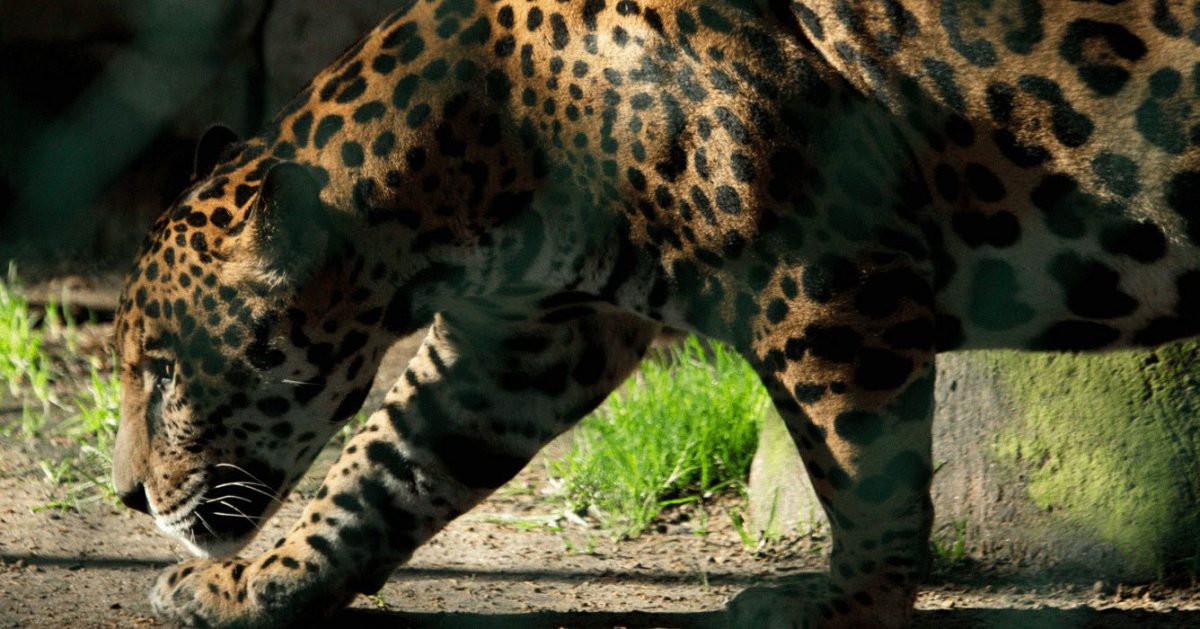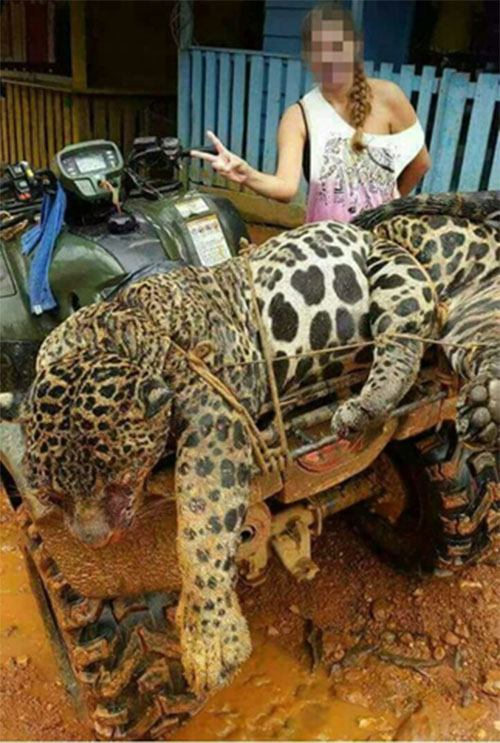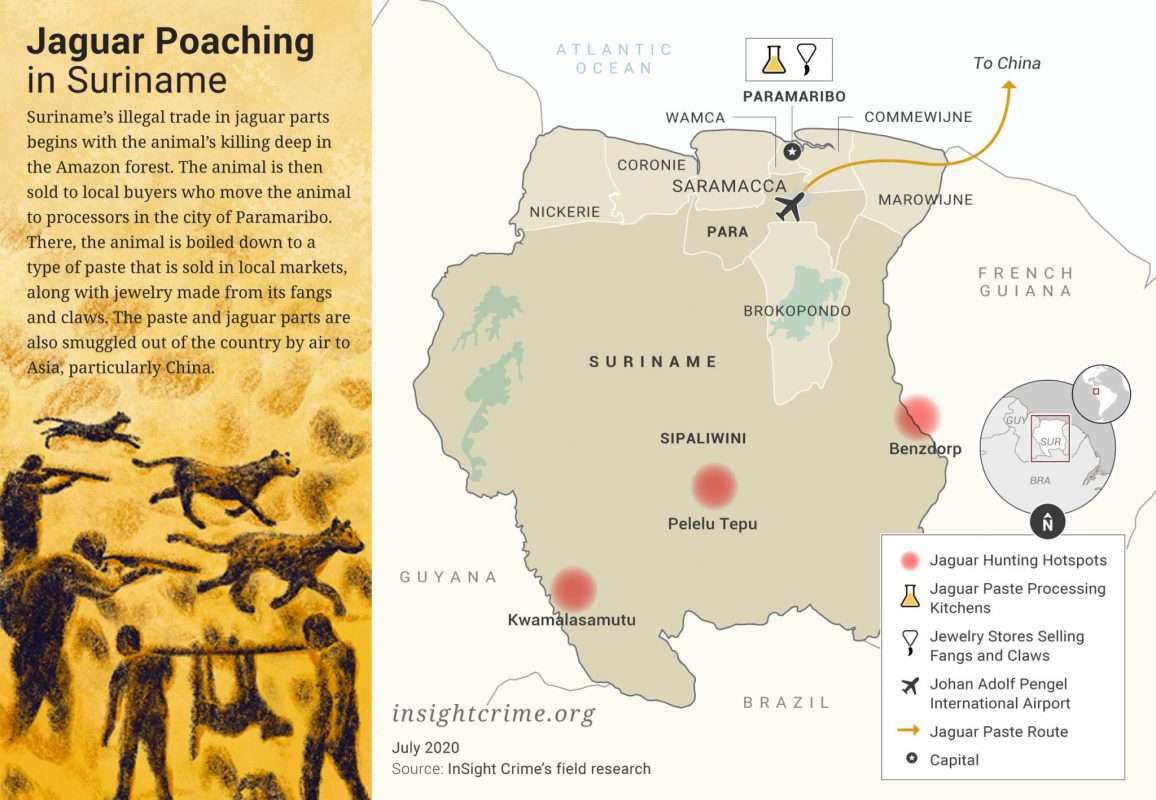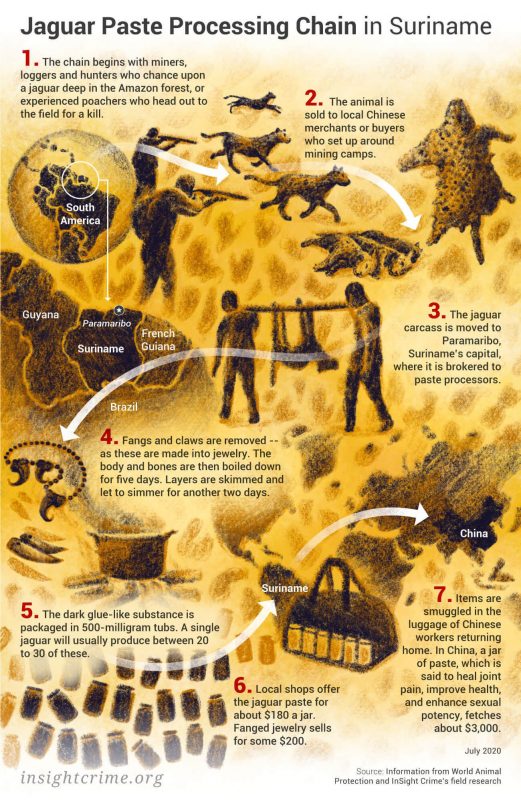Written by Sergio Saffón
InSight Crime
https://www.insightcrime.org/news/analysis/suriname-jaguar-trade-poaching-paste/
The jaguar’s head slumps over the back of an all-terrain vehicle. A lifeless paw outstretched above a large muddied tire provides a glimpse of its former mass and power.
A young woman stands behind the body of the dead cat, which is tied to the back of the four-wheeler. She smiles and makes a peace sign for the camera.
Trophy photos of jaguars hunted in Suriname have circulated in recent years as a way to attract potential buyers within the country’s local Chinese community, said Vanessa Kadosoe, a jaguar researcher with the Institute for Neotropical Wildlife and Envi-ronmental Studies (NeoWild). One woman, she recalled, claimed to have killed a jaguar to protect her livestock, and then tried to sell the carcass on Facebook.
Such images spread freely on social networks until about two years ago, when international media attention turned to jaguar poaching. Now similar ones are being shared clandestinely via the messaging application WhatsApp, and its Chinese equivalent, WeChat, said Nicholas Bruschi, an expert on the jaguar trade with animal welfare organization World Animal Protection.
The rise of jaguar poaching in Suriname provides a lesson in how a wildlife trafficking network can emerge opportunistically when interests collide — in this case natural resource extraction and Chinese investment — alongside a lack of wildlife crime policing. The chain links this small South American country to vast Asian black markets that have long prized medicinal products made from big cats, especially from tigers, which have grown scarce.
The trade begins with miners, loggers and hunters who chance upon a jaguar deep in the Amazon forest, or experienced poachers who head out to the field to kill a jaguar “on the off chance they can sell it, or if they already have a buyer lined up,” Bruschi told InSight Crime.
After the animal is killed, it is sold to local Chinese merchants who set up around the mining camps. The buyers broker the animal to processors in Suri-name’s capital, Paramaribo, who boil it down to a type of paste that is later smuggled out of the country, eventually reaching Asia.
“We believe the trade is a lot bigger than we realize,” Bruschi said. “It has been a blind spot in the last few years.”
Jaguar Poaching in the ‘Interior’
In Suriname, a jaguar’s best defense against poaching until recently was its habitat: a large jungle region known simply as the “interior” by locals.
But gold mining and logging concerns have moved into the dense Amazon forest that covers more than 90 percent of the country. From a plane’s passenger window, parched brown land is easily spotted where forest canopy has been stripped.
In 2018, gold accounted for $1.77 billion, or about 70 percent of Suriname’s export earnings, and extraction — both legal and illegal — is mostly carried out in small-scale mining pits.
The quest for new gold deposits has spurred miners — particularly locals and Brazilian nationals known as “garimpeiros” — deeper into the jungle, increasing their chances of encountering a jaguar, said Kadosoe, of NeoWild.
“There is a big relationship between mining and jaguar hunting,” she explained.
Miners know the dead animals can be sold to the Chinese merchants or roving buyers near the mining camps. The price is often agreed upon in grams of gold, Kadosoe said.
Ranchers also often kill jaguars stalking their cattle or roaming near settlements, and some hunters will “kill them opportunistically when they come across them in the forest, as a dead jaguar will finance their hunting trip,” said Pauline Verheij, an independent wildlife crime expert who has researched the jaguar trade in Suriname and Bolivia. Verheij has also heard reports of hunters specializing in poaching the big cats, luring them with live bait, such as baby goats or dogs.
Slicing across the south of Suriname is a line of three villages — Pelelu Tepu, Benzdorp and Kwamalasamutu — that have been deemed jaguar hunting hotspots, according to the conservationists. These amazon regions — which are likewise mentioned in a 2019 report by the National Committee of the Netherlands on wildlife poaching and trafficking in Bolivia and Suriname — are also home to Afro-Suriname and Indigenous people who commonly kill jaguars, the conservationists say.
For the poor living in the jungle, a dead jaguar brings in a good sum.
“Money is hard to come by, and they know there are ready buyers. They justify the kill by saying it helps to buy equipment or to feed their families,” Bruschi said.
“Hunters say everyone knows that the Chinese are looking for jaguars,” he said.
From Carcass to Paste
Jaguars in the Amazon were legally hunted for their hides until the 1970s. About 180,000 jaguars in the Brazilian Amazon were killed to meet the demands of the fur trade, in which skins were shipped in mass quantities to the United States and Europe.
Now, it is the jaguar’s body is more prized: boiled down into a paste that is used in traditional Chinese medicine. Foul-smelling and with the consistency of molasses, the paste is said to heal joint pain, improve health, and enhance sexual potency.
Paste manufacturing occurs in Paramaribo, Suriname’s capital. The buyers of jaguar carcasses move them to the city, often transferring a body among several vehicles before it reaches the paste processors, according to an August 2019 research paper in the journal Crime Science. Fangs and claws are removed first — as these are used in jewelry. Such items were sold in local shops for $200 in 2019, Kadosoe said, though the price is likely higher now.
The jaguar is then boiled down. Split in large pans, the carcass is cooked for five days. Layers, which eventually begin to form at the boiling water’s surface, are then skimmed off and let to simmer for another two days, according to the researchers.
“The bones are kept in with the body because they are believed to be potent,” Bruschi said. “The penis and other organs are generally used for other products, but the jaguar paste is attractive because it includes the bones and penis in one product.”
The dark glue-like substance is packaged in 500-milligram tubs. A single jaguar will usually produce between 20 to 30 of these, depending on the size of the cat.
According to Els van Lavieren, with the Suriname office of animal protection organization Conservation Inter-national, a jar of jaguar paste sells for about $180 in the local market. In China, the same jar fetches $3,000.
Traditional Chinese medicine has long used tiger parts, including bones. As the wild population of tigers has dwindled to some 4,000 animals, some conservationists say jaguar parts have emerged as substitutes.
In 2018, the jaguar population worldwide was roughly estimated to total 173,000. In Suriname, where jaguars are a protected species, population figures are unknown, Kadosoe said, because of a lack of funding for a national census.
“There are rumors of jaguars being killed every few weeks in certain seasons, only in Suriname,” Bruschi said, adding that jaguar poaching is also common in Bolivia, Brazil and other countries. “If that rate of poaching is happening, it is possible that jaguar products are being used as a substitute for tigers.”
Trafficking Chain to China
Chinese investment and migration have converged in Suriname, providing two elements for a trafficking chain to develop between the country — a wedge of rainforest lodged between Guyana, French Guiana and Brazil — and Asia.
Suriname received a wave of Chinese immigration that has substantially increased since the 1990s. Beijing also cultivated ties with Suriname’s government under former President Desiré Bouterse, a controversial figure voted out of office this year. Under Bouterse, Suriname’s debt to China rose to a billion dollars, a quarter of the country’s gross domestic product.
Chinese companies are now building highways in Parama-ribo, dredging the Suriname River, modernizing the main international airport, and providing the country with broadband internet infrastructure. In turn, it aims to acquire natural resources: State-run China Gold Intern-ational Resources Corp is interested in buying the Rosebel mine, the first large-scale open-pit gold mine in Suriname. The recent discovery of a large oil deposit has also become a focus of US and Chinese interests.
On the surface, such investment would seem to have little to do with jaguar poaching. But new research has found that Chinese investment in South American countries with jaguar populations is linked to an increase in the jaguar trade, according to a study published in June 2020 in the journal Conservation Biology.
Using a database of news reports of seizures of jaguars and jaguar parts in Central and South America, the researchers estimated that 857 jaguars had been killed for the illegal trade between 2012 and 2018. During that time, reports of jaguar parts seized — including teeth, skin and skulls — increased fivefold, according to the study led by Thais Morcatty of Oxford Brookes University in England.
By comparing countries’ gross national income per capita, corruption perception index scores, Chinese population, exports to China and Chinese private investment, the researchers determined that countries with relatively high corruption, Chinese investment and low income per capita had 10 to 50 times more jaguar seizures than the rest.
“The positive relationship between the number of jaguars seized and the amount of Chinese private investment may indicate that the legal market chain may provide structure for the illegal chain,” Morcatty and her colleagues wrote in their paper.
The study did not find a significant relationship between the number of Chinese residents and the jaguar trade, suggesting that jaguar smuggling is linked to more recent influxes of foreigners who “may still have fresh contacts with the Asian market,” whereas long-established Chi-nese communities may have integrated and have “less contact with people in their native country,” the researchers wrote.
In Suriname, Chinese immigrants have set up companies, groceries, casinos and restaurants, while more recent arrivals include laborers who build megaprojects and extract natural resources.
“It’s more complicated than blaming the Chinese or making the assertion that all the Chinese are involved,” Bruschi said. “Rather, it is a segment of the Chinese communities that have been coming over in the last two decades, following the investment, that have elements of mafia or organized criminal groups.”
Campaign image warning of jaguar poaching and parts smuggling. (Courtesy of Conservation International)
Prominent members of Suriname’s Chinese community have made efforts to stop the trade, and non-governmental organizations have raised awareness and launched media campaigns about poaching and the smuggling of jaguar parts.
But policing is severely lacking. To this day, no one has been prosecuted for jaguar poaching or trafficking in Suriname, said Verheij, the wildlife crime expert. Traffickers also don’t have to come up with complex smuggling schemes to China, as jaguar products are easily hidden in the luggage of workers returning home.
Although the penalty for these types of crimes is between four to six years in prison, the few cases where authorities have intercepted smugglers with jaguar parts have ended with little more than a fine, Verheij said. For example, three men were arrested at Suriname’s airport in 2018 with 19 jaguar teeth, some of which were turned into jewelry, as well as raw gold. But they were released after paying their fines, according to a Suriname news report.
And that’s one of the rare instances where the smugglers were caught. Fangs are easy to identify; the paste is not.
“A brown looking ointment in a small jar simply just doesn’t raise any red flags for most customs officials,” Verheij said. “And if it does, it is very hard to link it to a wildlife crime.”
https://www.insightcrime.org/news/analysis/suriname-jaguar-trade-poaching-paste/





